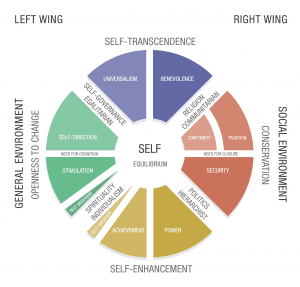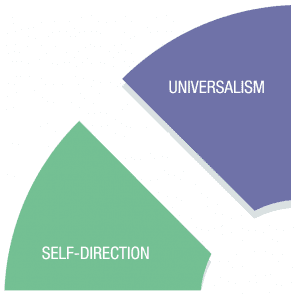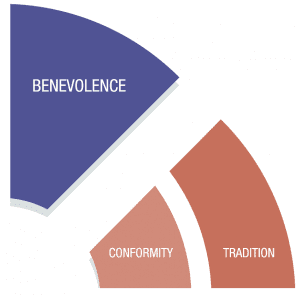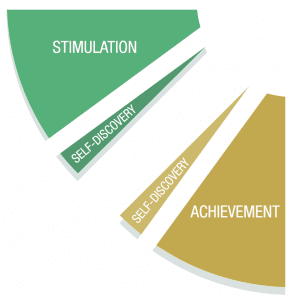Duval & Schwartz – The Internal Logic of Human Morality:
Picking up from where I left off last time, I will take nibbles at the radial nature of the model, whilst explaining its make-up, and what I see as the logical relations between the values, thereby hoping to make the implicit moral systems that it establishes more explicit. I will start at the highest level, drill down, and then note the inherent top-down/bottom-up nature of the dynamics of the system. Most of what I will be doing is discussing logical relations between concepts, so this is more philosophical than psychological. However, where I am aware of work that reinforces the point, I will reference it.

The General Environment:
Consider that the side labeled both as Left Wing and as General Environment can be thought of with respect to an individual embedded in the general environment. To illustrate this, we need merely look at the values that butt up against the dividing line between the general and the social, namely Achievement and Universalism. An individual can improve upon their personal best along any number of measures (weight, time, etc.). That is achievement. So, of course, is coming first, winning (epically, or otherwise). It is only in the context of others that achievement gives rise to power, at least as it relates to hierarchy (be that gold, silver, bronze, or upper class, middle class, working class). Having achieved something, you might wish that other people could achieve it, too. If you’re the last person on earth you are everyone, so Universalism is a single step from Achievement; no considerations of Power, Security, Conformity & Tradition, or Benevolence need enter into the equation. Equally Stimulation, Self-Discovery, Achievement, and Self-Direction no longer have such strong moral implications. Our understanding of the general environment is just that, OUR understanding: from our particular sense of red in the presence of a sunset, to our idiosyncratic understanding of gravity (it really does seem like larger rocks should fall faster, thanks to the – ill-named, in this context – ‘Folk Physics’). Note the central tendency of our relationship with the general environment: Need for Cognition. This is not a value; this is an attitude (a meta-motivation, maybe) that allows one to learn more about the (general) environment, in order to master it. Mastery reduces fear, trepidation, anxiety.
The Social Environment:
Note that the first segment after achievement is power. Defining a person by their achievement differentiates between people on the basis of power, and gives rise to hierarchy. Hierarchy is a means by which people will circulate with others that are “like” them (at the same level of achievement). Once the use of power has sorted people into their “natural” positions, security is attained, and then maintained through conformity (knowing your place). Maintain this “natural order” for long enough through the rules by which the power structure is defined and conformity becomes tradition (from the birthright of kings/dynastic succession, to the idea of class, to the Indian caste system). Once established in this structure, comfortable with, and comforted by, its predictability, one is in a position to enact Benevolence (“Preservation and enhancement of the welfare of people with whom one is in frequent personal contact”: Schwartz and Boehnke, 2004, p. 239[i]). If you value this structure, for whichever benefits it provides, you necessarily seek to conserve Security, Conformity, and Tradition. What of people from outside your caste, or class? How do you deal with “other” people?
It has been noted that Theory of Mind, the ability to think about what someone else might be thinking, is related to our ability to contemplate counterfactuals (e.g. Ferguson, Scheepers & Sanford, 2010[ii]). One need only look at theory of mind deficits, such as autism (Leevers & Harris, 2000[iii]) or schizo-phrenia (Kern, et al., 2009[iv]), and the impact on the ability to detect jokes, irony, or sarcasm, to see this relationship. This having been said, consider the impact of maintaining the counterfactuals that exist in the minds of everyone you know. This will very quickly get out of hand, or rather out of your mind (and thus the need for Cognitive Closure). The larger your social circle, the more you need to manage relations. Options would include:
- Not representing the minds of others until needing to do so;
- Representing the minds of others in a simplified form (aka stereotypes), or;
- Managing the types of people, and thus the likely content of their minds, in your in-group.
I think it likely that these options are adaptive, and most people will engage in all of these at different times. Issues arise with how these are deployed, and the extent to which they are relied upon.
1) Not representing the minds of other until needing to do so
Notice that the first half of this point is, in some ways, a description of both autism and schizophrenia. Autism can be seen as an aversion to other minds as sources of information (see LiveScience, 2012[v], for a brief overview with links to further reading). This aversion may be due to over-stimulation (other minds as sources of proliferating counterfactuals). On the other hand schizophrenia is a tendency to blur the self/other distinction (Langdon, et al., 1997[vi]). Thus, need for cognition (from non-social/general sources) at one end, and need for cognitive closure as (protection against social sources) at the other. Indeed, a recent paper on schizophrenia (van der Wieden, Prikken & van Haren, 2015[vii]) speaks specifically about the failures of the self-other distinction in schizophrenia, and notes the complexities of distinguishing this from self-other integration. Whilst not stated in their paper, issues with self-other integration is a near textbook description of autism. Other papers have noted the apparent polar relationship between the two (e.g. Crespi & Badcock, 2008[viii]). Van der Wieden, et al.’s diagram is nevertheless illuminating (see Fig. 2). This balance speaks to self-equilibrium between need for cognition and need for closure in the Schwartz-Duval framework.

2) Representing the minds of others in a simplified form (aka stereotypes)
The word stereotype is tarred with an unfortunate brush. Stereotypes are a necessity (see Epley, 2014, chapter 6, p. 117-140, for a discussion[ix]). However, using stereotypes in advance of stimuli is different to using stereotypes despite stimuli. If you have a need for cognition you are more to likely engage in the former, if you have a need for cognitive closure, you are more likely to adopt the latter.
3) Managing the types of people, and thus the likely content of their minds, in your in-group
We all have a tendency to surround ourselves with people like us, our in-group. This is where we seek solace and comfort, much as (securely attached) children return to mother’s knee before setting off to explore again. Those who have a need for cognition are more likely to go off and explore again, where-as those with a need for cognitive closure are less likely to do so.
The Quadrants:
The quadrants in the original Schwartz model, and in my proposed framework, find parallel with Haidt’s clusters, but do so without excluding the possibility of intervening types in a more continuous circle of political orientations. To explicitly state the relationship between Haidt’s clusters and this model:
Openness to Change is broadly of the left, and generally called liberal.
Conservation is broadly of the right, and generally called conservative.
Self-Enhancement is descriptive of Libertarianism, which, whilst containing both left- and right-leaning factions, is broadly seen as of the right.
Self-Transcendence is descriptive of the Religious Left who, as the name suggests, are more left than right.
If we were to place Harm and Fairness together between universalism and self-direction, and In-group, Authority and Purity together between security, conformity, and tradition, and then measure the distances around the circumplex to the central point of each quadrant we would get a model that is remarkably close to Haidt, Graham & Joseph’s (2009[x]) clusters (see Figure 3), particularly if we make allowance for the fact that Harm and Fairness are two values, and In-Group, Authority, and Purity are three, so a degree of additional dissipation across the shared values might be expected to occur.

Schwartz’s circumplex is a model predicated on a particular approach to minimum distance estimation (Schwartz & Boehnke, 2004). In particular:
We tested the model of 10 orthogonal factors with an ordinary CFA [Confirmatory Factor Analysis] on 10 latent variables. To test the theory-driven models of the value structure, we specified a reference matrix of expected correlations among the values for each model. This matrix represents exactly a pattern of expected correlations among the values that reproduces the model. We then tested the fit of the reference matrix to the observed data.
In order to create a reference matrix for a model, it is necessary to specify actual correlation coefficients that fit the expected pattern of associations of the model to be tested. Any set of arbitrarily chosen coefficients that fits the pattern of expected associations might be used, because the model must reproduce the pattern. Once reference values are chosen for any two correlation coefficients, all the remaining coefficients follow from the pattern needed to reproduce the model.
After a great deal of work, Haidt appears to have found values (Harm, Fairness, In-Group, Purity) that Schwartz didn’t use, but that fit in particular locations on the circumplex. Schwartz did use authority, and that actually appears under power. Harm is used in the description of conformity, and In-group is used in the description of benevolence, but neither was used as one of the values. Neither Fairness nor Purity appear in Schwartz’s circumplex. In other words, given the cross-cultural nature of Schwartz’s original circumplex, Haidt has gone to great lengths to find where American conservatism sits, and added a couple of values to the Schwartz lexicon in doing so.
In the Schwarz-Duval Framework, over and above what Haidt’s model offers, each quadrant (which seems to correlate with a Haidt cluster) has a name derived from their primary values. Furthermore a political designation can be derived from the boundary markers they exist between:
Openness to Change = Egalitarian Individualism/Liberal
Self-Enhancement = Hierarchical Individualism/Libertarian
Conservation = Hierarchical Communitarianism/Conservative
Self-Transcendence = Communitarian Egalitarianism/Religious Left
The names on the left relate to motivation and give rise to values, the names on the right are a general description of political orientation (a means by which to attain the thing so valued, through the use of power relating to that value). Note, however, that politics is inherently hierarchical in nature, at the bottom right of the circumplex. Each of these boundaries has been named by how it relates to politics. It seems likely that equally valid names could be derived for each quadrant boundary as they relate to religion. Though, with religions all developing from their own (usually unstated) politics, they tend to greater cultural (in-group) specificity and a greater inclination towards calling themselves righteous (the chosen people, etc.), and everyone else, sinners (or the relevant equivalent in the given religion).
The Quadrant Boundaries
Beyond the political orientations noted above, the quadrant boundaries contain the names of areas of human endeavor: Spirituality (or self-understanding, if you’re allergic to the word ‘spiritual,’ as I know some atheists and secularists are), politics, religion, and self-governance. Note that these spheres of endeavor have definitional values either side of them:
Spirituality – Self Discovery through Stimulation and/or Achievement
Politics – Power and Security
Religion – Conformity, Tradition, and Benevolence
Self-Governance – Universalism and Self-Direction
These four areas of endeavour happen to see an echo in the three major Eastern philosophies. The relationship between the three is illustrated by Zhu Jianqiu’s (1890-1965) version of the famous ‘Three Vinegar Tasters’.
 This painting “…depicts three scholars––a Confucian, a Buddhist, and a Taoist––tasting vinegar.
This painting “…depicts three scholars––a Confucian, a Buddhist, and a Taoist––tasting vinegar.
The Confucian frowns because the vinegar is sour. Much like how he believes society should be harmonised through established norms, he wants to neutralise the sourness.
The Buddhist also frowns. He thinks the vinegar is bitter. To him, everything material and not spiritual is bound to bring suffering.
The Taoist smiles, because he thinks that the flavour is just right. His philosophy in life is to follow the Dao, to find contentment whatever the objective situation may be. He doesn’t care what flavour it is. As long as the vinegar exists, there is something to be happy about.”
This explanation from Wong’s (2012[xi]) blog is the most useful I’ve seen.
The three philosophies have sometimes been considered as complementary parts of a greater whole (see Garrett, 1994[xii], for a discussion), sometimes called San Jiao or ‘harmonious as one.’ Of course attempting to bridge Eastern philosophy and Western psychology has had its problems (as Ho, 1995[xiii] suggests), and can smack of tokenism, but it can also lead to interesting (dare I say enlightening?) discussions on ethics (see, for example, Suen, Cheung & Mondejar, 2007[xiv]), and is surely a necessity for any claim to an essential understanding of the broader sweep of human nature (as exemplified by Dahlsgaard, Peterson & Seligman, 2005[xv]). It may be that Buddhism is spiritual, Confucianism is political, Taoism is religious, and that all make some reference to self-governance, hence why they are harmonious as one. If that were to be a creditable assessment of the three philosophies, it would go some way to showing the global applicability of the framework (and I invite specialists in Eastern philosophy and/or culture to critique that point).
To come back to the West, recall the difference of opinion between Schwartz and myself on the issue of spirituality and religion. In the present version of the model they form a continuum from private (spirituality) through to public (religion) passing through the centre of the circumplex. Note, also, that there is a continuum between politics and self-governance (which I chose to make explicit by using the latter term). Again, it is the balance between public self (politics) and private self (self-governance), passing through the centre that many (most? all?) would see as the ideal. Indeed, it is the imbalance that gives rise to the endless peccadilloes of the politically oriented (indeed one of the values under power is “preserving my public image” [Schwartz, 2012[xvi], p. 6]). A balanced position is the virtual definition of integrity, or even harmoniousness.
Integrity is a loaded term that, interestingly, doesn’t turn up in Schwartz’s work, and hardly at all in Haidt’s. The Stanford Encyclopædia of Philosophy (Cox, La Caze & Levine, 2013[xvii]) makes the point that “Integrity is one of the most important and oft-cited of virtue terms. […] it is sometimes used virtually synonymously with ‘moral.’” This reinforces the idea that one’s self and one’s morality are almost synonymous (suggesting that the individual is defined by what they value). Merriam-Webster (n.d.[xviii]) gives two primary definitions of integrity:
- the quality of being honest and fair
- the state of being complete or whole
Fairness is a primary concern of liberals, according to Haidt; and honesty comes under Benevolence, according to Schwartz. Benevolence is a primary concern of the religious left (when reading Haidt in light of Schwartz, as I have). By contrast, conservatives are concerned about fairness, but only as approximately equal to in-group, authority, and purity, i.e. “issues related to binding groups together” (Graham, Haidt & Nosek, 2009[xix], p. 1044).
An occasion where Haidt has definitely mentioned integrity is in Appendix D of the aforementioned paper (p. 1046), as part of a dictionary search for supporting terms. There it appears to be related to purity (and thus sanctity). Purity, as mentioned, is not a term that appears in Schwartz’s list of values. However, it is usually used in direct opposition to the value formerly known as hedonism. The value ‘clean’ (a reasonable match for purity) appears under security, not benevolence, conformity or tradition, again illustrating that religion has an (often) unstated politics at its core. So purity and integrity are at odds, at least when it comes to matters of public/private religiosity. Purity may refer to the state of being complete or whole, a kind of conforming/traditional (conceptual) purity, rather than one of honesty and fairness. This is also reflected in The Stanford Encyclopaedia of Philosophy’s discussion: “Persons of integrity may in fact act immorally—though they would usually not know they are acting immorally” (Cox, La Caze & Levine, 2013[xx]). This disjunction between personal integrity and conceptual integrity could well be the engine for what many liberals see as hypocrisy (and thus immorality) in the (particularly religiously) conservative. Conservative complaints of liberal immorality seem to arise from the same disjunction, but applied in the opposite way. Religion presents an idealized person that has conceptual integrity (e.g. being Christ-like) that is defiled by liberal traits centered on hedonism/self-discovery. Honesty (about oneself, including short-comings, etc.), which may be predicated on a greater degree of internalized self-understanding achieved through experiences (including pleasurable ones), will necessarily tarnish an idealized self. However, others would see such honesty as integrity.
Bound(ari)ed Rationality
These boundaries, which are themselves central tendencies for areas of human endeavor, can act as rough and ready reference points for a deeper discussion about the internal logic of the model. I will first illustrate the point with the example of Freedom. Discussed by Haidt after his creation of the Five Moral Flavours, as the sixth flavour. This was the first flavour to go against his “issues related to binding groups together” (Graham, Haidt & Nosek, 2009, p. 1044)… except that maybe it wasn’t.
Isaiah Berlin (1959/2002[xxi]) wrote about positive and negative Liberty. I must admit, I find the broader discussion, after Berlin, to be quite bamboozling. Just as I think I’ve got a handle on what one thinker means by negative freedom, something comes along that derails that definition. So let me proffer a discussion on the idea of freedom based almost entirely on its location on the circumplex, and the approximate relationship to the other quadrants (to undertake this task on a value-by-value basis may eventually be of use, and may be the reason for my bamboozlement at the discussion as it currently exists, but for now I am keeping the discussion simple).
Freedom
Let us start with the word itself, Freedom. It appears under the value of self-direction, alongside self-governance under the political heading of Egalitarian-Individualism. Its direct antithesis is Social Order, which appears under the value of security, alongside politics, under the political heading of hierarchical-communitarian. To be clear, freedom being antithetical to social order is a logical relationship between the concepts, and not indicative of their exact position on the circumplex – there is a degree of interpretation on my part. Freedom’s opposite if viewed through the lens of left vs. right/individual vs. societal may be seen as responsibility (which sounds like a discussion about the right of freedom vs. responsibility). If viewed as an entirely personal/internal struggle, then freedom’s opposite may be pleasure. However, these latter two, as far as logical relations are concerned, are orthogonal to freedom and social order on the circumplex, and in opposition to each other. As mentioned, on the left side is pleasure, which appears under the value of self-discovery, alongside spirituality (self-knowledge), under the political heading of hierarchical-individualist. On the right side is responsibility, under the value of benevolence, alongside religion, under the political heading of egalitarian-communitarian. I think there is as much tension between pleasure and responsibility as there is between freedom and social order, but equally I think they are all related. Note, again, that a balance between these views seems to give rise to integrity. The expression “Your right to swing your arms ends just where the other man’s nose begins” (Chafee, 1919, p. 957[xxii]) seems to balance freedom with social order, and pleasure with responsibility, pretty well.
If there is anything to the framework’s ability to clarify questions of morality, we should be able to derive answers to the following questions:
- Does freedom derive its primary meaning from the higher-level value of self-direction?
- Does politics put boundaries on freedom, grounded in concerns for social order?
- If so, is political freedom just personal freedom in light of concerns about social order?
- Is the right to self-determination (freedom by another name) predicated on or tempered by responsibility to one’s fellows?
- Is the expression of freedom predicated on or tempered by mastery of internal factors, such as placing short-term gain (pleasure) ahead of long-term gain (freedom)?
- Given their orthogonal relationship to freedom aren’t pleasure and responsibility just ways of saying ‘responsibility to yourself’ and ‘responsibility to others’, respectively?
- And don’t both, therefore, bear on freedom’s relationship to social order?
These are not meant as rhetorical questions, though I would be interested in hearing the reasoning behind any answer that isn’t ‘Yes.’
I previously suggested that, when one has internalized a value, whether due to some genetic predisposition or through an education process (or, rather, through some combination of the two), one tends to idealize its opposite. If libertarians are hierarchical-individualists, then they haven’t internalized Freedom, they are idealizing, possibly even fetishizing, freedom. What they believe in (have internalized) is the importance of the values that stand in the way of freedom: the internal drive for pleasure, and the external imposition of social order (hierarchy). By contrast, anarchists seem to have internalized the value of freedom, and have idealized the value of social order. By comparison, conservatives are hierarchical-communitarians; they also idealize freedom, but are cognizant of that which both stands in the way of and defines freedom: responsibility (and an implied social order). Of course, in this case, how narrowly one defines one’s in-group to which one has a responsibility very much impacts upon whom one has responsibility to. If you self-define more by your group than by yourself (the self-other distinction), and if that group is predicated on a particular trait, then you have bigotry, be it sexist, racist, nationalist, or whatever. Note, also, that whilst ostensibly concerned about the group, if your in-group is defined exclusively by a trait that you have, you are being responsible to yourself, by proxy (this is important for a later discussion).

To bring this back to Berlin’s (1969, pp. 121–22) discussion on positive and negative freedom:
Freedom: “What is the area within which the subject … is or should be left to do or be what he is able to do or be, without interference by other persons?” (Negative freedom.)
Social Order: “What, or who, is the source of control or interference that can determine someone to do, or be, this rather than that?” (Positive freedom.)
So this sets up the dichotomy in very left/right terms, freedom itself on the left, social order (“source of control”/politics) on the right. But I am suggesting that freedom is on the upper left, and social order on the lower right. To reflect the quadrants in the model we must provide a second negative (left) value, and a second positive (right) value, but with creditable reasons as to why (and whether) these variations exist.

Responsibility: ‘Occasionally, Berlin says, the defender of positive freedom will take an additional step that consists in conceiving of the self as wider than the individual and as represented by an organic social whole — “a tribe, a race, a church, a state, the great society of the living and the dead and the yet unborn”. The true interests of the individual are to be identified with the interests of this whole, and individuals can and should be coerced into fulfilling these interests, for they would not resist coercion if they were as rational and wise as their coercers. “Once I take this view”, Berlin says, “I am in a position to ignore the actual wishes of men or societies, to bully, oppress, torture in the name, and on behalf, of their ‘real’ selves, in the secure knowledge that whatever is the true goal of man … must be identical with his freedom” (Berlin 1969, pp. 132–33)’ (Carter, 2016[xxiii]). (Positive freedom?)

Notice here that one can invoke a more rightwing argument for responsibility via “a tribe, a race, a church, a state”, or a more leftwing equivalent via “the great society of the living and the dead and the yet unborn.” Where the religious left would probably invoke the whole lot, with all of the soul-searching that would necessitate. So self-construal impacts the way in which responsibility is deployed. Beyond this, due to its fascination with purity, religion would also often be against pleasure, which some liberals and libertarians might suggest is itself an expression of freedom.
Pleasure: “…Liberty … seems to require the presence of something (i.e. of control, self-mastery, self-determination or self-realization)” (ibid). (Negative freedom?)

Here again self-construal seems to interfere, or at least have the ability to do so. Is control or self-mastery grounded in religious views of purity, or in self-discovery unhampered by external interference? Are self-determination and self-realization not grounded in the very definition of freedom? Note that this latter question may stem from the fact that both freedom and pleasure appear on the left of the circumplex, and so may be less distinct in their differences than when freedom is considered in light of external/societal interference, in the form of social order and (expectations of) responsibility.
Two Positive and Two Negative Freedoms
This implies, at least in the case of Freedom, that we have a primary concept, Freedom. We have its logical antithesis, social order. And two orthogonal values, both of which can be tempered by their own logical opposites (each other), and both of which are quite dependent on self-construal. This impact of self-construal may be due to the fact that the orthogonal values of pleasure and responsibility are equidistant from freedom and social order, and so tug equally on a person’s concerns, but one is grounded in the internal concerns of the private self, and the other is grounded in the external concerns of the public self. This seems to provide a pretty good framework from within which we can discuss freedom.
…but can this be applied to other values?
The Golden Rule (Reciprocity)
In my original dissertation I drew a parallel between positive and negative liberty (per Berlin), and positive and negative reciprocity, aka the Golden Rule (and its metallurgic equivalents). The positive is expressed as, “Do unto others as you would have them do to you,” (The Golden Rule). The negat8ive version (The Silver Rule) is, “Do not do unto others as you would not have them do unto you” (but see Allinson, 1992[xxiv] & 2003[xxv], and Huang, 2005[xxvi], note 2, p. 417). Here, by negative, we mean a syntactic negative, not a feature of internal or external influence. This could lead to some confusion if not careful. Previously I mentioned Popper’s extension to the Golden Rule, that of his Platinum Rule, “…doing unto others, wherever possible, as they would be done by.” This makes the rule about the individual, not the group. So how you define an individual (and how well you engage empathy/theory of mind) impacts upon how you enact reciprocity right off the bat.
For reciprocity I will use the (Schwartz, 1992[xxvii]) value ‘reciprocation of favours’, which exists under the higher-order value of security. This immediately sets it up in approximate opposition to Freedom, based, as it is, on the social/right of the circumplex. Interesting to note that whilst reciprocity is frequently spoken about as a religious precept, it nevertheless exists in a quadrant that I contend is definitional of politics (I suggest that Confucius, to whom the Silver Rule is attributed, promulgated a political philosophy). However, it is reasonable to point out that reciprocity may be more related to fairness, a super-ordinate value that seemed to find expression through all higher-order values, in my experiment. Reciprocity does have the benefit of being less specific than reciprocation of favours, but in doing so it also opens the door for values like revenge.
As an aside: This positive/negative aspect of reciprocity mirrors quite closely the recent findings about the influence of oxytocin on interpersonal relationships (e.g. Olff, et al. 2013[xxviii]). “When social cues in the environment are interpreted as “safe” oxytocin may promote prosociality but when the social cues are interpreted as “unsafe” oxytocin may promote more defensive and, in effect, “anti-social” emotions and behaviors” (ibid., p. 1883-1884). Included amongst these unsafe cues, if you’re a monogamously pair-bonded male? Attractive women (Scheele, et al., 2012[xxix]). In addition, “If a social experience is negative or stressful, the hormone activates a part of the brain that intensifies the memory. Oxytocin also increases the susceptibility to feeling fearful and anxious during stressful events going forward” (Paul, 2013[xxx]). However, it seems as though oxytocin is responsible for feeling ‘loved-up,’ well, at high intra-nasal doses, it increases positive thoughts about oneself (Cardoso, Ellenbogen & Linnen, 2012[xxxi]). So oxytocin seems to interact with anxiety (making individuals more groupish and more anxious – and monogamous men more likely to find attractive women aversive), whereas without anxiety, the same neuropeptide may increase positive self-regard along with the bonding and trust aspects that it has generally been associated with (ibid.). (With thanks to Kat Arney[xxxii] for these links).
If someone does you a favour, with the expectation of reciprocation, that action may be grounded in ideas about security, e.g. you scratch my back, and I’ll scratch yours. However, as with freedom, the orthogonal values seem to play an important part in how one understands this action. Was this favour granted instrumentally as part of that individual’s ambition? Or was it grounded in a benevolence-value such as honesty (in other words, was it prosocial or not)? Notice here, that as with freedom, benevolence may also be interpreted with a more rightwing argument for benevolent honesty to a fellow member of “a tribe, a race, a church, a state”, or a more leftwing equivalent via “the great society of the living and the dead and the yet unborn.” Either way, a contender for possible logical opposite to reciprocation of favours is ‘choosing own goals,’ which is to say that a person’s action towards you does not necessarily impact on your actions towards that person (you can choose not to reciprocate, possibly due to the ambition/honesty factor).
Whilst not as in depth as the discussion on freedom, and with a lengthy aside – the above does seem to achieve similar ends. I think the idea of taking a value, its opposite, and the two orthogonal values, has shown itself as a useful construct for discussing morals and how morality arises.
Conclusion
The primary relationship that the circumplex seems to represent is between the self (self-construal) and one’s response to the general and social environments. That being said, self-construal is primarily about the internal representation of the self with reference to the general and social environments. Values seem to arise as a reinforcement of internal representations interacting with external reality. It seems uncontroversial to say that a child, with a given genetic make-up, and thus proclivities and preferences, will interact with their environment, and that interaction may magnify or modify their internal state. As we saw with oxytocin, high levels are likely to interact with upbringing (parenting style: Olff, et al. 2013), and other predispositions, like anxiety (Paul, 2013) or positive self-regard (Cardoso, Ellenbogen & Linnen, 2012), both of which it, and parenting-style, can magnify. In response, the central trait on the left is openness to change (a non-anxious trait – recall Fredrickson’s (2001[xxxiii]) ‘Broaden and Build’), whereas the central trait on the right is need for closure (an anxiety-reducing trait).
Whilst the two sides do represent a political reality, the circumplex gives rise to two quadrants that have, as their central traits, the central traits of the left and right. The other two quadrants are blends of outer aspects of the left and right. The self-enhancement quadrant (hierarchical individualist, or libertarian) has traits from the left, but trending rightwards, and the self-transcendence quadrant (communitarian egalitarian, or religious left), from the right, but trending leftwards.
These quadrants are defined by their relationships with human endeavours, such as spirituality and self-governance on the left, politics and religion on the right. These do a useful job of providing anchor points for a discussion about morality. The positions of freedom, social order, pleasure, and responsibility, with respect to self-governance, politics, spirituality, and religion, respectively, allow for a nuanced discussion of freedom that goes beyond the classical positive/negative (left/right), and may indeed clarify this debate. A similar pattern seemed to work pretty well for a (brief) discussion about reciprocity.
The next installment will look at the individual segments, and how one might build up a morality, and a moral epistemology from these building blocks, in the context of the Schwartz-Duval Framework. (But before that, here’s a brief discussion about the relationships (in my data) between Haidt’s moral flavours.)
NOTES
[i] Schwartz, S. H., & Boehnke, K. (2004). Evaluating the structure of human values with confirmatory factor analysis. Journal of research in personality, 38(3), 230-255.
[ii] Ferguson, H. J., Scheepers, C., & Sanford, A. J. (2010). Expectations in counterfactual and theory of mind reasoning. Language and Cognitive Processes, 25(3), 297-346.
[iii] Leevers, H. J., & Harris, P. L. (2000). Counterfactual syllogistic reasoning in normal 4-year-olds, children with learning disabilities, and children with autism. Journal of Experimental Child Psychology, 76(1), 64-87.
[iv] Kern, R. S., Green, M. F., Fiske, A. P., Kee, K. S., Lee, J., Sergi, M. J., … & Nuechterlein, K. H. (2009). Theory of mind deficits for processing counterfactual information in persons with chronic schizophrenia. Psychological Medicine, 39(04), 645-654.
[v] http://www.livescience.com/36187-autism-eye-contact-thinking-behavior.html
[vi] Langdon, R., Michie, P. T., Ward, P. B., McConaghy, N., Catts, S. V., & Coltheart, M. (1997). Defective self and/or other mentalising in schizophrenia: a cognitive neuropsychological approach. Cognitive Neuropsychiatry, 2(3), 167-193.
[vii] van der Weiden, A., Prikken, M., & van Haren, N. E. (2015). Self–other integration and distinction in schizophrenia: A theoretical analysis and a review of the evidence. Neuroscience & Biobehavioral Reviews, 57, 220-237.
[viii] Crespi, B., & Badcock, C. (2008). Psychosis and autism as diametrical disorders of the social brain. Behavioral and Brain Sciences, 31(03), 241-261.
[ix] Epley, N. (2014). Mindwise: How We Understand What Others Think, Believe, Feel and Want. London: Penguin, Allen Lane.
[x] Haidt, J., Graham, J., & Joseph, C. (2009). Above and below left–right: Ideological narratives and moral foundations. Psychological Inquiry, 20(2-3), 110-119.
[xi] https://williamyswong.wordpress.com/2014/12/11/我也會吃醋/
[xii] Garrett, M. M. (1994). The Three Doctrines Discussions’ of Tang China: Religious Debate as a Rhetorical Strategy. Argumentation & Advocacy, 30(3), 150-161. http://buddhism.lib.ntu.edu.tw/FULLTEXT/JR-ADM/garrett.htm
[xiii] Ho, D. Y. (1995). Selfhood and identity in Confucianism, Taoism, Buddhism, and Hinduism: contrasts with the West. Journal for the Theory of Social Behaviour, 25(2), 115-139. http://iaccp.org/sites/default/files/ho_1995_0.pdf
[xiv] Suen, H., Cheung, S. O., & Mondejar, R. (2007). Managing ethical behaviour in construction organizations in Asia: How do the teachings of Confucianism, Taoism and Buddhism and Globalization influence ethics management? International Journal of Project Management, 25(3), 257-265.
[xv] Dahlsgaard, K., Peterson, C., & Seligman, M. E. (2005). Shared virtue: The convergence of valued human strengths across culture and history. Review of General Psychology, 9(3), 203-213.
[xvi] Schwartz, S. H. (2012). An Overview of the Schwartz Theory of Basic Values. Online Readings in Psychology and Culture, 2(1). http://dx.doi.org/10.9707/230720919.1116
[xvii] Cox, D., La Caze, M. & Levine, M. (2013). “Integrity”, In Edward N. Zalta (ed.), The Stanford Encyclopedia of Philosophy, http://plato.stanford.edu/archives/fall2013/entries/integrity/
[xviii] Integrity. (n.d.). Retrieved April 30, 2016, from http://www.merriam-webster.com/dictionary/integrity
[xix] Graham, J., Haidt, J., & Nosek, B. A. (2009). Liberals and conservatives rely on different sets of moral foundations. Journal of personality and social psychology, 96(5), 1029-1046.
[xx] Cox, D., La Caze, M. & Levine, M. (2013). “Integrity”, In Edward N. Zalta (ed.), The Stanford Encyclopedia of Philosophy, http://plato.stanford.edu/archives/fall2013/entries/integrity/
[xxi] Berlin, I. (1959/1969/2002). Two Concepts of Liberty, in I. Berlin, Four Essays on Liberty. London: Oxford University Press.
[xxii] Chafee, Z. (1919). Freedom of speech in war time. Harvard Law Review, 32(8), 932-973.
[xxiii] Carter, I. (2016). “Positive and Negative Liberty”, in Edward N. Zalta (ed.), The Stanford Encyclopedia of Philosophy, http://plato.stanford.edu/archives/spr2016/entries/liberty-positive-negative/
[xxiv] Allinson, R. E. (1992). The golden rule as the core value in Confucianism & Christianity:
Ethical similarities and differences. Asian Philosophy, 2(2), 173-185.
[xxv] Allinson, R. E. (2003). Hillel and Confucius: The prescriptive formulation of the golden rule in the Jewish and Chinese Confucian ethical traditions. Dao, 3(1), 29-41.
[xxvi] Huang, Y. (2005). A Copper Rule Versus the Golden Rule: A Daoist-Confucian Proposal for Global Ethics. Philosophy East and West, 55(3), 393-425.
[xxvii] Schwartz, S. H. (1992). Universals in the content and structure of values: Theoretical advances and empirical tests in 20 countries. Advances in Experimental Social Psychology, 25(1), 1-65.
[xxviii] Olff, M., Frijling, J. L., Kubzansky, L. D., Bradley, B., Ellenbogen, M. A., Cardoso, C., … & van Zuiden, M. (2013). The role of oxytocin in social bonding, stress regulation and mental health: An update on the moderating effects of context and interindividual differences. Psychoneuroendocrinology, 38(9), 1883-1894.
[xxix] Scheele, D., Striepens, N., Güntürkün, O., Deutschländer, S., Maier, W., Kendrick, K. M., & Hurlemann, R. (2012). Oxytocin modulates social distance between males and females. The Journal of Neuroscience, 32(46), 16074-16079.
[xxx] Paul, M. (2013, July). The love hormone is two-faced. In Northwestern. Retrieved May 12, 2016, from http://www.northwestern.edu/newscenter/stories/2013/07/the-love-hormone-is-two-faced.html
[xxxi] Cardoso, C., Ellenbogen, M. A., & Linnen, A. M. (2012). Acute intranasal oxytocin improves positive self-perceptions of personality. Psychopharmacology, 220(4), 741-749.
[xxxii] https://twitter.com/harpistkat
[xxxiii] Fredrickson, B. L. (2001). The role of positive emotions in positive psychology: The broaden-and-build theory of positive emotions. American Psychologist, 56(3), 218-226.















